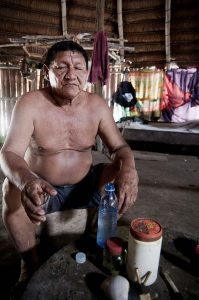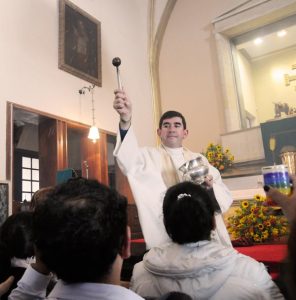by Roberta Staley

After years spent travelling to some of the more grim areas of the world without getting sick, the Patron Saint of Safe Travel, Saint Christopher, seemingly abandoned me. Here I was in a little hotel in Bogotá in Colombia, puking my guts out for the fourth day in a row.
In between throwing up, I stuffed my worn backpack with notepads, pens and camera for a trip into the Amazon to visit several indigenous groups. Was it possible to survive a trek through a steamy jungle while so ill? I was almost too weak to care.
The flight from Bogotá to Leticia on Colombia’s southernmost tip, booking into a hotel and meeting my guide and translator were all conducted in a haze of wretchedness. The guide, Elias Cuao, shook his head at my condition. The next morning I threw up again (for good luck?), squeezed into a dented yellow taxi and set out for the jungle, taking the two-lane highway out of Leticia to its end. Literally. We and the cab fled, leaving us staring at an oppressive wall of Amazon green.
I managed to keep up with Cuao, following him over a dozen bridges of felled narrow tree boughs, cut by the indigenous inhabitants of the forest, that provide a pathway through the Amazon’s circulatory system of streams and torpid rivers. Birds shrieked and squawked. Pendulous oropendola nests hung from tree boughs. Fluorescent blue butterflies the size of my hand flitted about within arm’s reach. About 45 minutes later, Cuao hooted: “Makuna! Makuuunnnaaa!” laughing as the words echoed through the canopy of branches. We had reached our first destination — an enormous one-room cabaña with a wall of vertical wooden planks and a steep roof made of grey-weathered interlacing palm fronds. Cuao was alerting Baribú Geraga ‘Gustavo’ Mejia Makuna, the group’s political leader (payé) and medicine man (kuraca), of our arrival. Gustavo, a 59-year-old man with a naked expanse of brown belly and genial expression, gave Cuao a bear hug then beckoned us into the “Big House.” We were directed to several rough-hewn log benches that were grouped around a tree-stump table. Cuao and Gustavo, as he liked to be called, shared a sacred ritual: stuffing enormous wads of pale green, finely ground coca leaves — the basis of cocaine — into their cheeks.
I flipped open my notepad and Gustavo began a singsong recitation, describing the spiritual and symbolic importance of plants like coca and tobacco and the gods associated with these plants. Then, for some reason — was I swooning? — Cuao stopped Gustavo and explained how sick I was, using the universal hand gesture for retching, much to my embarrassment. Gustavo spoke to Cuao who turned to me and said, “He will make you better.”
My deep-rooted Western cynicism rose up like bile but dissipated just as quickly — skepticism required too much energy. Gustavo took my plastic bottle of water and placed it on the tree stump. He began to chant, a melodic locution rooted in the lower registers. His eyes looked upwards but his vision was turned inwards. He moved his hands in a graceful ballet around the bottle, then got up and stood immediately behind me. I couldn’t see Gustavo, but sensed that his hands were engaged in the same slow lyrical dance. Frissons of energy snapped my body like elastics. Gustavo returned to his seat and Cuao translated, “Drink the water, you will feel better.” Gustavo also gave me a small wad of the bitter coca leaves to dissolve in my mouth.
Cuao later told me that Gustavo has an encyclopedic store of memorized knowledge about Amazonian plants and animals — “enough to fill 10 textbooks” — passed down from his kuraca father. To a kuraca, some illnesses — like mine — are simply a form of negative energy that can be exorcised to restore health.
Plants are also used to alleviate many illnesses. As we padded across the spongy ground through the trees, Gustavo stopped to point out common natural remedies. Picking a red flower, Gustavo squeezed the bulbous stamen end, causing it to ooze a clear, thick liquid that is used to cure earaches. Another broad-leaf plant, called anyago, counteracted the poison of snakebite. Even the rubber tree is a source of medicine; its milky sap soothes stomach ailments and it is a cosmetic depilatory for hair. Meanwhile, thread is created from the chambira palm, Gustavo said, rolling a leaf vein between his hands to turn it into thin, malleable string.
When we returned to the Big House, a generous lunch of meat, vegetables and soup had been laid out on wooden tables. I was able to sip some broth, the first food I had had in five days. I still felt weak, but the sensation that my body had been invaded by demons was gone. In the two hours that had elapsed since Gustavo had negotiated peace with my virulent interlopers, I had, apparently, healed.
Why? Had the microbes simply run their course? Was I so desperate to be healed (and I was) that I was ‘cured’ by placebo effect? Perhaps the ground coca, which traditional healers say has both medicinal and analgesic effects, made me better. Was it Gustavo’s collaboration with the spirits that excised my illness? Or, was it a combination of all these things?
My illness and subsequent healing seemed the perfect metaphor for the embattled state of the Amazon, which is disappearing at an alarming rate, according to the United Nations Environment Programme. This Garden of Eden not only provides for the needs of all those who exist within its emerald embrace but is a cornucopia of pharmaceuticals. My healing came about in a way that was unexplainable. It is but one of the many mysteries of the Amazon that needs to be researched before the healing powers of this great green living organism disappears forever in an ongoing commercial plunder of its resources.
About the author
Roberta Staley is an award-winning magazine editor and writer with experience reporting from the developing world and conflict and post-conflict zones, including Afghanistan, Haiti, Colombia, Cambodia and Soweto.
She is the editor of the national science magazine, the Canadian Chemical News, and teaches magazine writing in Douglas College’s Communications Department. Staley is also a graduate student at Simon Fraser University.
http://journeystotheedge.com – Blog
http://robertastaley.ca – Website
Photo: Tallulah Photography
